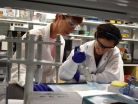(Press-News.org) A small fraction of pregnancies occur in women with epilepsy but a new study suggests those women may be at higher risk for complications and death during delivery, according to an article published online by JAMA Neurology.
Between 0.3 percent and 0.5 percent of all pregnancies occur in women with epilepsy. However, there is inadequate data on obstetrical outcomes so the risk of adverse outcomes and death in this population of women remains largely unquantified.
Sarah C. MacDonald, B.Sc., of the Harvard T.H. Chan School of Public Health, Boston, and coauthors looked at obstetrical outcomes including maternal death, cesarean delivery, length of stay, preeclampsia, preterm labor and stillbirth in a retrospective study of pregnant women identified through hospitalization records from 2007 to 2011. A total of nearly 4.2 million delivery-related discharges were included in the study group and of these 14,151 were women with epilepsy. Nationwide, this represented 69,385 women with epilepsy and about 20.4 million women without epilepsy in more than 20.5 million total discharges.
The authors found that women with epilepsy had a risk of death during delivery hospitalization of 80 deaths per 100,000 pregnancies, which is higher than the 6 deaths per 100,000 pregnancies found among women without epilepsy. The authors acknowledged several caveats including that their data lacked the ultimate causes of death during delivery among women with epilepsy. They also noted that while the risk of death is higher, the death of a mother during delivery is still very rare even among women with epilepsy.
"Regardless of the specific cause, the point that women recorded as having epilepsy have an increased risk of mortality remains a clinically relevant message suggesting that increased attention should be paid. Future research is needed to determine the specific causes of mortality and how interventions might improve outcomes," the authors write.
The study also suggests women with epilepsy were at increased risk for other adverse outcomes, including preeclampsia, preterm labor and stillbirth. The women also had increased health care utilization, including an increased risk of cesarean delivery and prolonged hospital stay, regardless of delivery method, the study concludes.
(JAMA Neurol. Published online July 6, 2015. doi:10.1001/jamaneurol.2015.1017. Available pre-embargo to the media at http://media.jamanetwork.com.)
Editor's Note: This work was supported by the National Institute for Mental Health and the Eunice Kennedy Shriver National Institute of Child Health and Human Development of the National Institutes of Health. Please see the article for additional information, including other authors, author contributions and affiliations, financial disclosures, funding and support, etc.
Editorial: Risks of Epilepsy During Pregnancy; How Much Do We Really Know?
In a related editorial, Jacqueline A. French, M.D., of the Langone School of Medicine at New York University, and Kimford Meador, M.D., of the Stanford University School of Medicine, Palo Alto, Calif., write: "The MacDonald et al study provides important new information and demonstrates several risks associated with pregnancy in WWE [women with epilepsy]. However, it raises far more questions than it answers. Most WWE have uncomplicated pregnancies. We need to understand the mechanisms underlying these risks, including death, so that we can identify the specific population at risk and devise interventions to reduce these risks. Future studies need to confirm and build on the present findings to improve the care of WWE during pregnancy."
(JAMA Neurol. Published online July 6, 2015. doi:10.1001/jamaneurol.2015.1356. Available pre-embargo to the media at http://media.jamanetwork.com.)
Editor's Note: The authors made conflict of interest disclosures. Please see the article for additional information, including other authors, author contributions and affiliations, financial disclosures, funding and support, etc.
INFORMATION:
Media Advisory: To contact corresponding author Sarah C. MacDonald, B.Sc., call Marjorie Dwyer at 617-432-8416 or email mhdwyer@hsph.harvard.edu. To contact corresponding editorial author Jacqueline A. French, M.D., call Ryan Jaslow at 212-404-3525 or email Ryan.jaslow@nyumc.org. An audio interview with authors will be available when the embargo lifts on the JAMA Neurology website.
To place an electronic embedded link in your story: Links will be live at the embargo time: http://archneur.jamanetwork.com/article.aspx?doi=10.1001/jamaneurol.2015.1017 and http://archneur.jamanetwork.com/article.aspx?doi=10.1001/jamaneurol.2015.1356
Cognitive behavioral therapy is a widely used nonpharmacologic treatment for insomnia disorders and an analysis of the medical literature suggests it also can work for patients whose insomnia is coupled with psychiatric and medical conditions, according to an article published online by JAMA Internal Medicine.
Previous meta-analyses have suggested that cognitive behavioral therapy for insomnia can improve sleep, although many of these studies excluded individuals with co-existing psychiatric and medical conditions.
Jason C. Ong, Ph.D., of Rush University Medical Center, ...
MADISON - The newfound ability of a protein of the intestines and lungs to distinguish between human cells and the cells of bacterial invaders could underpin new strategies to fight infections.
Writing this week (July 6, 2015) in the journal Nature Structural and Molecular Biology, a team led by University of Wisconsin-Madison Professor Laura Kiessling describes the knack of a human protein known as intelectin to distinguish between our cells and those of the disease-causing microbes that invade our bodies.
"This has the potential to change the game in terms of how ...
Studying brain scans and cerebrospinal fluid of healthy adults, scientists have shown that changes in key biomarkers of Alzheimer's disease during midlife may help identify those who will develop dementia years later, according to new research.
The study, at Washington University School of Medicine in St. Louis, is published July 6 in JAMA Neurology.
"It's too early to use these biomarkers to definitively predict whether individual patients will develop Alzheimer's disease, but we're working toward that goal," said senior author Anne Fagan, PhD, a professor of neurology. ...
A blood-borne molecule that increases in abundance as we age blocks regeneration of brain cells and promotes cognitive decline, suggests a new study by researchers at UC San Francisco and Stanford School of Medicine.
The molecule in question, known as beta-2 microglobulin, or B2M, is a component of a larger molecule called MHC I (major histocompatibility complex class I), which plays a major role in the adaptive immune system. A growing body of research indicates that the B2M-MHC I complex, which is present in all cells in the body except red blood cells and plasma cells, ...
What gives plastic objects their flexibility and reduces their brittleness is the concentration of plasticiser. For example, a chemical solvent of the phthalate family called DOP is often used. The trouble is there are concerns that phthalates present health risks. So there is a demand for more alternatives. Now, scientists from China have examined the effect of using DEHHP, a new eco-friendly plasticiser, used in combination with PVC. For a plasticiser to work, there has to be adequate hydrogen bonding with the plastic. By combining experiments and simulations, the team ...
Nearly 800 million people worldwide don't have access to safe drinking water, and some 2.5 billion people live in precariously unsanitary conditions, according to the Centers for Disease Control and Prevention. Together, unsafe drinking water and the inadequate supply of water for hygiene purposes contribute to almost 90% of all deaths from diarrheal diseases -- and effective water sanitation interventions are still challenging scientists and engineers.
A new study published in Nature Nanotechnology proposes a novel nanotechnology-based strategy to improve water filtration. ...
Optogenetics techniques, which allow scientists to map and control nerve cells using light stimulation, are being used to study neural circuits in the brain with unprecedented precision. This revolutionary technology relies on light-sensitive proteins such as channelrhodopsins, and researchers at UC Santa Cruz have now determined the molecular mechanism involved in the light-induced activation of one of these proteins.
The new findings, published July 3 in two papers in the Journal of Biological Chemistry, can help scientists create tailor-made proteins optimized for ...
Evolutionary change in a gene resurrected in the lab from the extinct woolly mammoth altered the gene's temperature sensitivity and likely was part of a suite of adaptations that allowed the mammoth to survive in harsh arctic environments, according to new research. In a study published in Cell Reports on July 2, 2015, researchers determined the whole-genome sequence of two woolly mammoths and three modern Asian elephants, predicted the function of genetic changes found only in the mammoths, and then experimentally validated the function of a woolly mammoth gene reconstructed ...
An international team, led by a University of Adelaide genetics expert, has made a breakthrough discovery which is expected to help thousands of young girls worldwide who are suffering from a rare yet debilitating form of epilepsy.
Professor Jozef Gecz, from the University of Adelaide's Robinson Research Institute, was a key player in identifying the responsible gene and mutations in this female-only epileptic syndrome, in 2008.
In breakthrough research published in Oxford Journals, Human Molecular Genetics, Professor Gecz has now found a treatment for this disorder. ...
(PHILADELPHIA) -- Transfer RNAs (tRNAs) are ancient molecules and indispensable components of all living cells - they are found in all three kingdoms of life i.e., in archaea, bacteria and eukaryotes. In a cell, they are part of the machinery that translates messenger RNA (mRNA) sequences into amino acid sequences.
In recent years advances in sequencing technology have enabled detailed investigations of the RNA molecules that are active in a cell. A study published July 6th in the journal Oncotarget reports on a newly discovered category of tRNA fragments as well as ...

